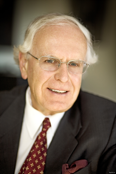Zdeněk P. Bažant Received Honorary Membership in ASME
Zdeněk P. Bažant Received Honorary Membership in ASME
 NEW YORK, November 20, 2012 — Zdenek P. Bažant, Ph.D., a resident of Evanston, Ill., and McCormick Institute professor and W.P. Murphy professor of civil and mechanical engineering, and materials science at Northwestern University, was honored by the American Society of Mechanical Engineers (ASME). He was recognized for groundbreaking contributions to engineering science, particularly the microplane constitutive model, statistical-energetic strength scaling law for distributed fracturing, theory of creep and hydrothermal effects in concrete nuclear structures, sea-ice strength scaling theory, and stability criteria for shear-deformable and three-dimensional structures. He received Honorary Membership in ASME.
NEW YORK, November 20, 2012 — Zdenek P. Bažant, Ph.D., a resident of Evanston, Ill., and McCormick Institute professor and W.P. Murphy professor of civil and mechanical engineering, and materials science at Northwestern University, was honored by the American Society of Mechanical Engineers (ASME). He was recognized for groundbreaking contributions to engineering science, particularly the microplane constitutive model, statistical-energetic strength scaling law for distributed fracturing, theory of creep and hydrothermal effects in concrete nuclear structures, sea-ice strength scaling theory, and stability criteria for shear-deformable and three-dimensional structures. He received Honorary Membership in ASME.
First awarded in 1880, the founding year of the Society, Honorary Membership recognizes a lifetime of service to engineering or related fields. The award was conferred on Dr. Bažant at the Society's annual Honors Assembly held in conjunction with the 2012 ASME International Mechanical Engineering Congress and Exposition, held in Houston, Nov. 9 through 15.
Bažant is internationally renowned for his seminal work on solid mechanics and structures. He has been on the faculty at Northwestern University since 1969, serving in various professional and administrative positions including director of the Center for Concrete and Geomaterials (1981-87).
His research interests include mechanics of materials and structures, and structural safety, with emphasis on the mechanics of fracture, damage and creep, size effects and scaling, impact, modeling, probabilistic mechanics, nano-mechanics, poromechanics and hydrothermal effects. His groundbreaking concepts have been applied to numerous areas including the modeling of concrete, fiber composites, tough ceramics, rocks, soils, bone, snow and sea ice; and the safety of bridges, tall buildings, aircraft, ships and nuclear structures.
Bažant's size effect law, as well as his crack band model and nonlocal model which automatically exhibit the size effect, have been used in structural engineering, in composites for ships, aircraft and automobile structures; highway pavement tests; the prediction of sea ice breakage; wave-code finite element simulations of terrorist explosions, ground shock and missile impact on hardened structures and rock; and in nuclear containment safety analysis.
In recent years he has become interested in the analysis of overall structural failures. He provided a detailed analysis of the collapse of the Twin Towers in New York City and also produced a comprehensive study of the creep and service life of a large number of bridges in the U.S. and elsewhere.
An ASME Fellow, Bažant has served on various technical committees in the Applied Mechanics and Materials divisions. He received the Society's Worcester Reed Warner Medal in 1997, the Nadai Medal in 2008 and the Timoshenko Medal in 2009.
In addition to his many professional associations, Bažant was induced into the National Academy of Sciences, the National Academy of Engineering, the American Academy of Arts and Sciences and six European National Academies.
Bažant received his Ing. degree in civil engineering from Czech Technical University (CTU) in Prague in 1960. He earned his Ph.D. in engineering mechanics at the Czechoslovak Academy of Sciences, Prague, in 1963. In 1967, he earned his docent (habilitatis) in concrete structures at CTU. He holds seven honorary doctorates. Bažant is a registered structural engineer in Illinois.
About ASME ASME helps the global engineering community develop solutions to real world challenges. Founded in 1880 as the American Society of Mechanical Engineers, ASME is a not-for-profit professional organization that enables collaboration, knowledge sharing and skill development across all engineering disciplines, while promoting the vital role of the engineer in society. ASME codes and standards, publications, conferences, continuing education and professional development programs provide a foundation for advancing technical knowledge and a safer world. For more information visit www.asme.org.



